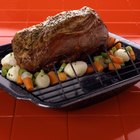
As exotic -- or offal-ish -- as pork spine sounds, you can clear up any confusion about how to cook it by treating it as just another gelatinous, meaty pork bone, not unlike ham hocks. You have two main choices when it comes to cooking pork spine: stock or soup. Both use similar techniques, and you start both with a solid purging and blanching to remove impurities.
Preparing the Spine
Pork spines come broken down into individual vertebra, but that's about all the prep you can expect. First, soak the bones for about two hours to purge the blood, then scrub them with a stiff brush under cool running water. Blanch the bones in boiling water for about 10 minutes to purge them of impurities and the protein byproducts that seep from them when they first come in contact with heat. Alternatively, you can oil the bones and roast them in a 400-degree Fahrenheit oven for 30 minutes. Roasting the bones also makes for a dark broth or soup base with a roasted, smoky flavor.
Spine Stock
The technique for making stock from pork spine is the same as for other meat stocks, but the finished product tends to have more fat. Let the spine cool to room temperature after you blanch or roast it, then place it in a stockpot. Add about 1 quart of water for every pound of spine along with basic stock aromatics: chopped onions, carrots and celery, and black peppercorns, bay leaf and parsley stems. Simmer the spine until the liquid reduces to about 4 cups, skimming the surface of froth with a spoon as needed. Strain the stock through a sieve lined with cheesecloth and into a storage container, and let it cool to room temperature. Place the stock uncovered in the freezer until the fat solidifies on the surface, about 30 to 45 minutes. Remove the hardened fat from the stock and discard it.
Spine Soup
Korean cuisine's gamjatang, or pork bone soup, is probably the most popular, or at least the most visible, pork spine dish. Blanch about half of a small cabbage for a couple minutes and cut it into bite-sized pieces. Cover the bones with 1 or 2 inches of cold water in a stockpot. Add diced onion, ginger and mushrooms then simmer for about two hours, adding water as needed to keep the bones covered. Make a sauce comprising a couple tablespoons each chili powder, soy paste, minced garlic, rice wine, anchovy sauce and water. Strain the soup through a sieve lined with cheesecloth into another pot and add the bones to it. Add the sauce, cabbage, mung bean sprouts, diced potatoes, ground sesame seeds and simmer until the potatoes are tender.
Other Spine Uses
You can use the stock made from pork spine in a number of other preparations, particularly Southern dishes that use a ham-based broth. You can substitute spine stock for ham stock in ham and bean soup, braised collard greens, lentil soup, steam-fried potatoes, pinto beans and black eyed pea soup, to name a few dishes. Spine stock is versatile, but only for pork-based dishes or dishes that use ham or bacon as a garnish. For example, you don't want to use the stock for chicken soup or beef stew.
Related Articles

How to Cook Bacon Bones

How to Cook Dried Abalone

How to Cook Prime Rib Bones in a Slow ...

How Long Can You Cook Beef Ribs at 300 ...

How to Tenderize Gizzards

How to Make Celery Soup

How to Make Fish Stock

How to Cook a Beef Spleen

How to Cook a Whole Sirloin Tip Beef ...

How to Cook a Pork Breast Bone

How Long Do You Cook Shank Meat for ...
How to Cook Beans & Soup Bones in a ...

Extracting Bone Marrow for Cooking

How to Make Sinigang

How to Cook Fresh Pork Tongue

How to Braise Pork

How to Make Collard Greens With Smoked ...

Ideas for Cooking Boston Butt Strips

How to Cook Pork Loin
How to Cook Honeycomb Beef Tripe
References
Writer Bio
A.J. Andrews' work has appeared in Food and Wine, Fricote and "BBC Good Food." He lives in Europe where he bakes with wild yeast, milks goats for cheese and prepares for the Court of Master Sommeliers level II exam. Andrews received formal training at Le Cordon Bleu.
Photo Credits
Jupiterimages/Photos.com/Getty Images